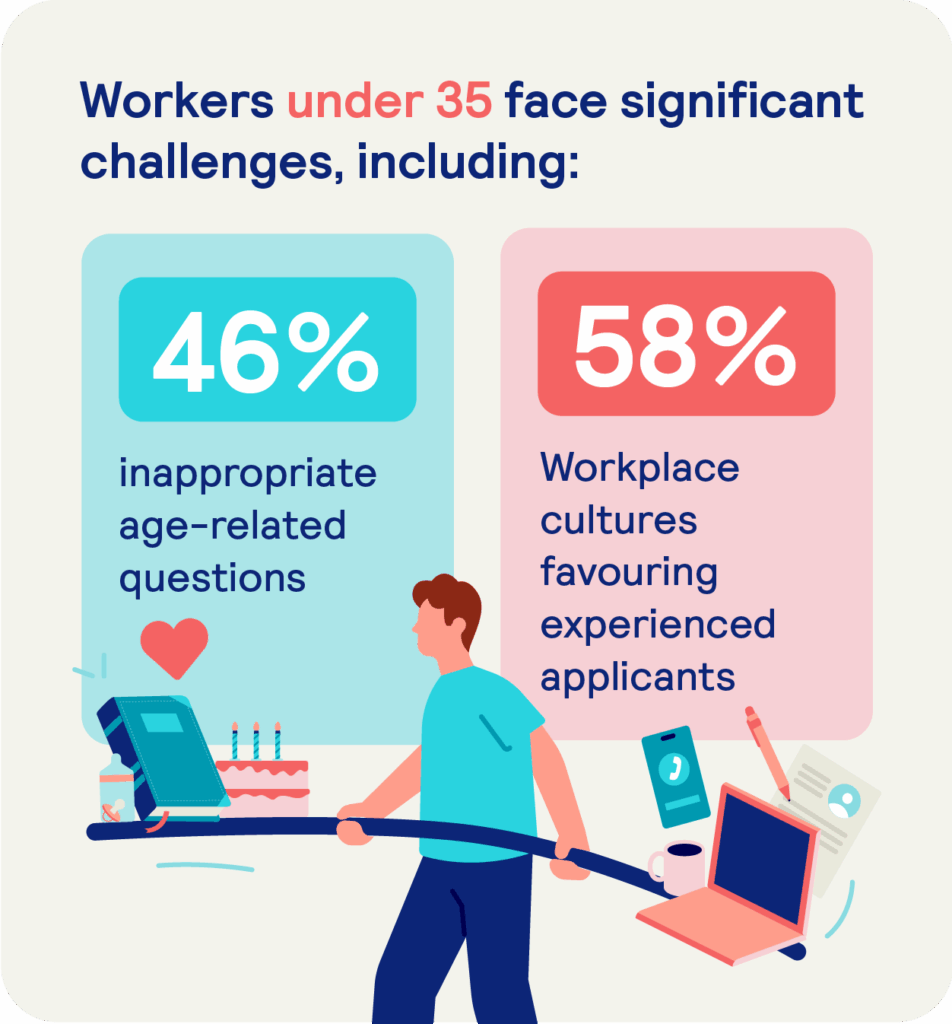
Gen Z’s job search takes double the effort compared to older workers
Table of Contents
- Key takeaways
- The job search gap
- The impact of age bias on young jobseekers
- The importance of inclusive hiring practices
- About the research
1 in 3 Gen Z workers worry about getting rejected for jobs due to their age. Our research highlights the ageism young workers face during their job search.
Key takeaways
- Gen Z submit an average of 24 job applications before securing a role, compared to 12 for Gen X and 11 for Baby Boomers.
- Half (52%) of Gen Z candidates have faced assumptions that their age makes them less reliable or loyal to employers.
- 34% of young professionals worry about being rejected for jobs due to their age.
- Over half (56%) of Gen Z have considered accepting positions below their qualifications, while over two-fifths (46%) have excluded their age from CVs.
“Young, bold and thriving” is how one might think Gen Z is regarded, but half (52%) of young professionals today say it’s assumed they are less reliable and loyal to employers due to their age.
Our report ‘The Age Advantage’ investigates age bias in hiring, with a focus on the experiences of older talent. However, our research found that ageism affects both ends of the age spectrum, with 34% of Gen Z workers worrying about being rejected for jobs due to their age.
In this article, we explore the impact of ageism in the workplace against young people and ways to overcome the barriers they face.
The job search gap

Starting their job search, Gen Z workers (those born between 1997 and 2012) often feel uncertain about their prospects.
1 in 3 (34%) professionals between the ages of 18 and 28 worry about being rejected for jobs due to their age. This stems from a few factors, including taking longer to secure a job and stereotypes about younger workers.
We found that Gen Z workers submit 24 applications on average to secure a job, which is twice the number of applications compared to Gen X and Baby Boomers. As young professionals submit more applications and consequently wait longer to be considered for a job, their confidence in their job prospects lowers.
In fact, they believe they lack relevant experience (12%) or skill (10%) for desired roles and feel underqualified (9%). Young women are especially more likely to feel they lack the experience required for the roles they want (22%).
As a result, over half (56%) of Gen Z have considered accepting positions below their qualifications, while over two-fifths (46%) have excluded their age from CVs.
Age perceptions holding younger workers back
Stereotypes fuel age bias and negatively impact young professionals when it comes to landing a job.
3 in 5 (59%) HR decision-makers admit they make age-based assumptions about candidates, and one assumption younger professionals face frequently is being more likely to switch jobs – making them less reliable or loyal in the eyes of employers.
Despite preconceptions, Gen Z is just as likely as any other generation to be motivated primarily by salary to change jobs (37%). However, young professionals place equal importance on flexible working (22%) and training and career development opportunities (19%).

In fact, Gen Z place significantly higher value on growth and skill-building. Leaning into the attributes of younger workers, such as their desire to upskill and grow, can help employers unlock a skilled future workforce.
The impact of age bias on young jobseekers
Younger workers are more likely to report age bias than other generations, such as being turned down based on their age or for not being the “right cultural fit“.
Young professionals are increasingly aware of and vocal on issues around discrimination in the workplace and employers that are not taking steps to address age bias can have difficulties attracting and retaining talent.
It’s crucial for employers to include age diversity as part of their DEI (diversity, equality, and inclusion) strategy and address ageism in hiring and the workplace.
Gen Z is looking for flexibility, training and development, attractive benefits and strong relationships with colleagues which indicate they want workplaces with a positive company culture.
Explicit rejections for being ‘too young’

Almost 2 in 5 (41%) young professionals have been explicitly rejected due to their age, despite the ban against age discrimination under the Equality Act.
Employers must train hiring managers and choose a panel of age diverse hiring decision makers in their recruitment process to protect candidates against age bias and their business against repercussions.
I was in an interview and when I finished the interviewer told me that I was excellent in the interview but unfortunately I won’t be employed because they wanted older and more mature people for the role.
James, 25
The oversight on ageism can damage an employer’s reputation and employer branding, causing them to lose out on talent. Meanwhile, such experiences discourage younger candidates.
Hesitation to enter the job market

As we mentioned, younger workers believe their age may prevent them from securing job offers. Almost 1 in 3 (32%) candidates under 35 hesitate when applying for jobs in fear of being considered too young.
Gen Z workers are also more likely to feel underqualified for roles. These hesitations are based on younger workers’ experiences with ageism during the hiring process.

For example, over two-fifths (46%) of workers under 35 have received inappropriate age-related questions, for example around family plans. Furthermore, the number one reason younger workers say they were rejected for a role is not being the right cultural fit. In such cases, 58% reported that it was implied a preference for more experienced employees.
As a result of their experience with ageism, 56% of younger workers consider roles below their qualifications. This means younger workers settle for less and can’t fulfil their potential, while employers inadvertently lose out on a skilled future workforce.
The importance of inclusive hiring practices
Addressing age bias is not only beneficial for both younger and older people in the workplace, but also important in fostering intergenerational workplaces.
Businesses increasingly need skilled people, and inclusivity is the only way to bridge skills gaps and continue fostering innovation. While older workers bring years of experience and expertise, younger people bring new ideas, tech-savviness, social media skills, and a desire to learn and grow.
Employers that tap into the benefits of a multigenerational workforce will be winners in a challenging labour market. We found that 55% of employers are yet to implement strategies to increase age diversity, but inclusive hiring practices are essential for businesses to thrive today and in the future.
To improve inclusivity and ensure inclusive hiring practices, employers could:
- Train hiring managers to recognise and avoid age-based discrimination during the recruitment process
- Build age-diverse hiring panels to remove unconscious age bias
- Focus on skills and competencies instead of age and experience
- Ensure job ads include unbiased and neutral language
- Consider ‘cultural add’ instead of ‘cultural fit’ to focus on what candidates can add
- Provide flexible working to appeal to a wider talent pool
- Guide candidates in preparing for their interview by providing information about the role as well as your company
Check out The Age Advantage report for more practical advice and understanding age bias within recruitment.

Our research indicates that unconscious biases still prevent many businesses from fully accessing this vital talent pool. Businesses that embrace training and onboarding the fresh perspectives of younger workers will be better positioned to address talent shortages and nurture a skilled workforce for the future.
Natalie Matalon, Chief People Officer at The Stepstone Group
Building a multigenerational workforce isn’t just about hiring—it’s about creating a working environment where every generation can thrive. When older workers’ experience and younger workers’ fresh ideas come together, businesses unlock incredible potential for innovation and growth.
By embracing age diversity and breaking down stereotypes, employers can foster collaboration, creativity, and a culture where everyone feels valued, laying the foundation for long-term success.
About the research
The data was collected through an online survey by Opinium Research from 24th July to 1st August 2024. 4,000 UK workers completed the survey, and was weighted to reflect the age, gender, and regional distribution of the British workforce. Data from 1,000 UK HR decision makers was collected through an online survey by Opinium Research from 31st July – 9th August 2024.
Explore articles
Receive the latest recruitment resources and
advice to boost your hiring
By providing us with your details you agree to our privacy policy and for us to keep you updated with the latest news, events,
and special offers from Totaljobs.






